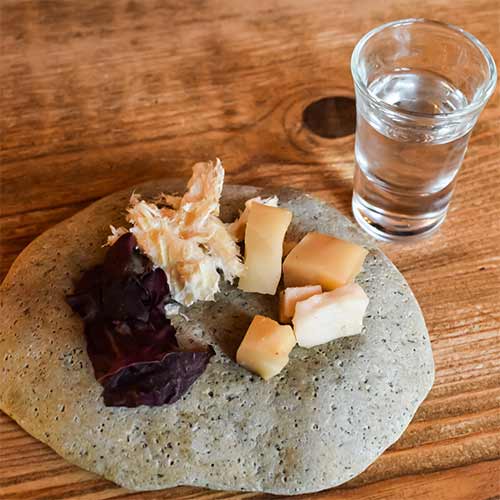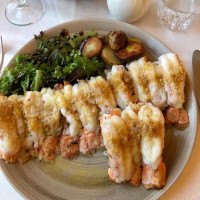The many natural phenomena and sights of Iceland are often already known to visitors, but many tourists have no idea what to expect when it comes to Icelandic specialties.
The roots of Icelandic cuisine lie in Scandinavia because the island's settlement in the 9th century also introduced the country's typical Nordic traditions and customs. A particularly important point of the cuisine at that time: was to preserve food as long as possible, because there were no refrigerators. For this reason, a lot of meat was dried or fermented in Iceland. Fresh vegetables and fruits were also scarce in early Iceland: the weather was too cold and the soil too hard. But there was one plentiful ingredient then, as there is today: fish. And since Iceland is surrounded by the sea, it's not surprising that fish and seafood are a big part of Icelandic cuisine. Since the Vikings, Iceland's culinary diversity has expanded. Nowadays, you can buy mostly the same products in Iceland as you can in our country. But most traditional dishes still revolve around fish, lamb, dairy products, bread, and potatoes. We present some of these Icelandic specialties in this blog and reveal which dishes you should try when visiting Iceland.
Fish dishes
Harðfiskur - dried fish
This Icelandic delicacy is very popular among the locals. No matter if as a real meal or as a small snack in between, the Icelanders love their dried fish! Usually, cod, haddock, or sea bass is hung up to dry for four to six weeks until the fish is hard. It is then pounded with a meat tenderizer to soften it and make it edible. In this process, the fish can be eaten plain or with butter or dark bread. Our tip: dried fish is a great source of protein when hiking!
Plokkfiskur - fish stew
The traditional fish stew Plokkfiskur has been cooked by Icelanders for generations. It is so popular that almost every Icelandic family has its own recipe for the hearty stew. The main ingredients are very simple: fish fillets (usually cod or haddock), potatoes, onions, and white sauce. It is usually served with traditional rye bread.
 Hákarl - Fermented Shark (Greenland Shark)
Hákarl - Fermented Shark (Greenland Shark)
This dish is best known for its austere taste: fermented Greenland shark. To preserve the shark meat, it is fermented for at least a month and a half and then dried. The preparation consists of several lengthy steps. First, the shark is gutted and cleaned, then aged for several weeks (6 to 7 weeks in summer, 2 to 3 months in winter) in permeable wooden crates. Then the meat is hung in an open drying shed where it dries for another two to four months. Greenland shark meat is poisonous to humans, and only the long fermentation process makes the meat edible. In restaurants, hakarl is usually served with a shot of Brennivín, Iceland's national brandy, to wash down the taste quickly. Despite the harsh taste, trying this specialty is part of a visit to Iceland.

Langoustine - Icelandic lobster
Usually caught on the south coast of Iceland, Icelandic lobster is offered in many restaurants. The lobster is more like a langoustine, as it is smaller than other lobsters and you only eat the tail. Lobsters are also very expensive in Iceland, but even so, they come in many different forms of preparation: fried, baked, grilled, and even on pizza. You can also buy frozen lobster tails in most supermarkets.
Meat dishes
Hangikjöt - smoked lamb meat
In general, the Icelandic lamb is considered perhaps the best lamb in the world. Translated, Hangikjöt means "hanging meat", as it used to hang in the kitchen house for a long time. Traditionally, it is smoked by hanging it from the rafters of a smokehouse. The smoked lamb is part of the traditional holiday or Christmas meal in many families and is popular with locals and tourists alike.

Kjötsúpa - hearty meat soup
Meat soup is one of Iceland's national dishes and is usually prepared from sheep, lamb, or mutton. Together with root vegetables and potatoes, the meat is cooked in a broth. This delicacy is on the menu not only in restaurants all over the island but also in some gas stations. The Icelandic specialty is also often offered at all kinds of festivals.
Svið - Sheep head
Svið is boiled sheep's head, because traditionally all parts of the sheep were used after slaughter. Icelandic cooks cut the head in half, clean the outside and remove the hide, then boil it in hot water for at least an hour. Traditionally, the head is served with mashed turnips or potatoes. The taste of the meat can be compared to that of mutton. The dish is still very popular, especially among older Icelanders, which is why it can be found in the freezer section of many supermarkets. It is also a part of the traditional meal for the festival þorrabló
 Pylsa - Icelandic Hot Dog
Pylsa - Icelandic Hot Dog
Pylsa are immensely popular with the locals and the restaurants and stalls offering hot dogs are almost always busy (even in low temperatures and rain). The very low price compared to Icelandic food makes the pylsa a popular street food. Unlike hot dogs in other countries, the sausage for Icelandic pylsa is usually made from lamb. The hot dogs are served with fried or raw onions, red cabbage, and sweet mustard.
Bread
Rúgbrauð - Dark rye bread
The traditional rye bread of the Icelanders is baked in a pot or steamed in special wooden barrels buried in the ground around thermal springs. By steaming, the bread does not develop a crust and it remains juicy. The rather sweet taste of the bread goes well with butter, smoked salmon pate, smoked lamb, pickled fish, or cheese. Rugbraud can be found in almost all grocery stores in Iceland.
Sweet dishes
Icelandic ice cream
Icelanders are crazy about ice cream even when temperatures are low. Many ice cream parlors are open all year round, some even at night. There are no limits to the flavors offered: From traditional flavors, such as vanilla, to typical Icelandic flavors, such as licorice, to very special flavors, such as Rúgbrauðsís (rye bread ice cream, consisting of crumbled rye bread, eggs, cinnamon, vanilla, and milk), there is something for everyone. Another popular ice cream dish in Iceland is Bragðarefur. Here, any type of ice cream is mixed with selected toppings consisting of fresh fruits, sweets, and other sauces.
Kleinur
The boiling pastry is very common not only in Iceland but in the whole Scandinavian region. However, unlike in other Nordic countries, it can be bought in Icelandic bakeries and supermarkets all year round. Kleinur is a crispy donut that is twisted into a specific shape before being fried. The dough is flavored with nutmeg and cardamom during preparation, which gives the donuts a very special taste. After baking, the pastry is sprinkled with a light layer of sugar. Freshly baked and lukewarm they taste best.

Pönnukökur
These Icelandic pancakes are usually served for breakfast, tea or as a dessert. The filling is usually Rabarbarasulta (rhubarb jam) or whipped cream. The pancakes are baked as thinly as possible in a special pan that is passed down from generation to generation in the family. Also, similar to a cast iron pan, it is not washed. Thus, with each use, the non-stick coating is sealed naturally.

Skyr - Icelandic yogurt
Skyr is a traditional dairy product, well known beyond the borders of Iceland, with a consistency similar to quark. Due to its high protein and low-fat content, skyr is a popular breakfast and is often combined with fresh fruit or muesli. In Iceland, skyr has been an integral part of the cuisine for centuries, but consumption of it is also spreading more and more in other countries. In the meantime, many European grocery stores sell one or more varieties of Icelandic delicacy.
Icelandic drinks
Brennivín
Brennivín, or brandy, is probably the best-known Icelandic liquor and is often drunk with traditional foods. It is made from fermented grain and is flavored with caraway seeds.
Malt og Appelsín
The official Christmas drink of the Icelanders is a somewhat bizarre one: they mix the Icelandic orange lemonade Appelsín with malt beer.
Controversial dishes
Whale meat
The consumption of whale meat is now very controversial in Iceland. Although Iceland continues to catch minke whales, the main consumers of whale meat in Iceland are now tourists. Whale meat is now of little importance in Icelandic cuisine.

Puffin meat
The meat of the sweet birds is also considered a delicacy in Iceland and the Faroe Islands, and unlike other nations, hunting for puffins is still permitted. In restaurants, the meat is usually served grilled or smoked.
